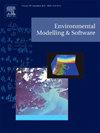LSTM 记忆状态是否反映了复杂度降低的沙质海岸线模型中的关系
IF 4.8
2区 环境科学与生态学
Q1 COMPUTER SCIENCE, INTERDISCIPLINARY APPLICATIONS
引用次数: 0
摘要
基于平衡的模型是模拟海岸线变化的一种透明方法,但往往过于简单,无法捕捉复杂的动态变化。与此相反,深度学习方法以牺牲透明度为代价,却能提供更强的预测能力。在这项研究中,我们仔细研究了 LSTM 海岸线模型的内部运作。我们使用基于回归的探针来证明,负责过去到未来信息流的细胞状态向量会自主生成类似于 ShoreFor 模型中基于物理学的平衡项 Ωeq 的平衡信息。对整个训练过程中探测技能的变化进行了跟踪,结果表明,在 6 个横断面中的 5 个横断面,LSTM 能够有意义地获取平衡信息(ΣΔR2 = 0.3-0.6)。这项工作的结果证明,LSTM 可以用内部方法模拟海岸线变化,这与目前对海岸线动态的理解是一致的。这些具有物理意义的表征强调了机器学习与基于物理的方法共同进化的重要性。本文章由计算机程序翻译,如有差异,请以英文原文为准。
Do LSTM memory states reflect the relationships in reduced-complexity sandy shoreline models
Equilibrium-based models are a transparent method of modelling shoreline change, though often too simplistic to capture complex dynamics. Conversely, deep learning methodologies offer greater predictive power at the expense of transparency. In this research we scrutinize the internal workings of an LSTM shoreline model. A regression-based probe is used to show that cell state vectors, responsible for past-to-future information flow, autonomously generate equilibrium-like information akin to the physics-based equilibrium term of the ShoreFor model, . The variation in probe skill throughout training is tracked to show that at 5 of 6 transects, the LSTM was able to meaningfully acquire equilibrium information (ΣΔR2 = 0.3–0.6). The results of this work offer evidence that an LSTM may model shoreline change with internal methods that are consistent with the current understanding of coastal shoreline dynamics. These physically meaningful representations emphasize the importance of co-evolution between machine learning and physics-based approaches moving forward.
求助全文
通过发布文献求助,成功后即可免费获取论文全文。
去求助
来源期刊

Environmental Modelling & Software
工程技术-工程:环境
CiteScore
9.30
自引率
8.20%
发文量
241
审稿时长
60 days
期刊介绍:
Environmental Modelling & Software publishes contributions, in the form of research articles, reviews and short communications, on recent advances in environmental modelling and/or software. The aim is to improve our capacity to represent, understand, predict or manage the behaviour of environmental systems at all practical scales, and to communicate those improvements to a wide scientific and professional audience.
 求助内容:
求助内容: 应助结果提醒方式:
应助结果提醒方式:


